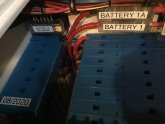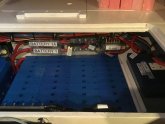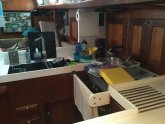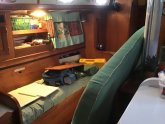John Simmons
New Member
- Joined
- Feb 1, 2020
- Messages
- 44
I am in the midst of replacing my 800Ah 12V AGM house sell bank with 40 of the fortune 100AH Cells. 10 cells as a parallel set, then each set in series For a total of 1000 Ah at 12V. The BMS I am using will be the Electrodaucus because I did not want to chance having the power suddenly die if the BMS craps out, which is the case if you use a FET based BMS. I am a live aboard, and all of my charging systems can be reprogrammed for Lithium including the Balmar regulator. Charging and battery monitoring is all done and taken care of, no worries there.
The idea of going completely to all fortune cells for a separate start bank rather than the gel/agm cell sounds Very attractive.
Start loads would be either the 6.5kW northern lights 3 cylinder diesel, or the 59hp Volvo diesel. Neither of these are big motors. The starters are TINY, we are not talking about a 500 hp Detroit Diesel. I was wondering if it might make sense to make a starting battery bank out of 8 other fortune cells, 12 V 200 Ah, but this time NO BMS. I have all remote meters and can switch charging sources from alternator, solar, or generator. Is there ANY reason not to use the lithium batteries for starting?
I have read that a normal car start motor is around 1 hp, so that makes it 746 watts, let’s say 1 kW. At 12 volts that is only Amps, and for only a few seconds.
Am i missing something? The 8 cell fortune bank should not have a problem at all with that.
Thanks in advance for any feedback.
John
The idea of going completely to all fortune cells for a separate start bank rather than the gel/agm cell sounds Very attractive.
Start loads would be either the 6.5kW northern lights 3 cylinder diesel, or the 59hp Volvo diesel. Neither of these are big motors. The starters are TINY, we are not talking about a 500 hp Detroit Diesel. I was wondering if it might make sense to make a starting battery bank out of 8 other fortune cells, 12 V 200 Ah, but this time NO BMS. I have all remote meters and can switch charging sources from alternator, solar, or generator. Is there ANY reason not to use the lithium batteries for starting?
I have read that a normal car start motor is around 1 hp, so that makes it 746 watts, let’s say 1 kW. At 12 volts that is only Amps, and for only a few seconds.
Am i missing something? The 8 cell fortune bank should not have a problem at all with that.
Thanks in advance for any feedback.
John








